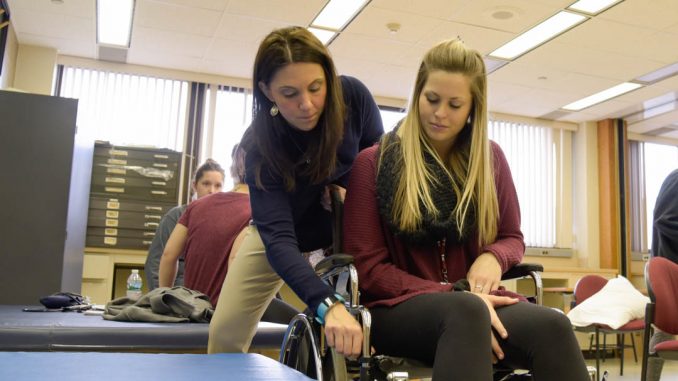
Ruth Farber remembers unpacking tables, chairs and weaving looms — which were used as therapeutic tools — to furnish the occupational therapy department 50 years ago.
“It felt like an adventure,” she said.
Farber was one of eight students in the occupational therapy program’s first graduating class in 1969. In 2017, as the American Occupational Therapy Association celebrates its 100th anniversary, Temple’s program celebrates its 50th. The department will host an anniversary reception on March 31 at the Pennsylvania Academy of the Fine Arts.
More than two decades after she graduated, Farber earned her doctorate of counseling psychology from the College of Public Health in 1993 and joined Temple’s occupational therapy faculty the same academic year.
According to the American Occupational Therapy Association, the purpose of occupational therapy is to “help people across the lifespan participate in the things they want and need to do through the therapeutic use of everyday activities.”
The strategies used by occupational therapists vary greatly from patient to patient, said Roger Ideishi, the director of the rehabilitation sciences program. Despite a common misconception, Ideishi said the word “occupation” refers not to jobs, but to social roles, like children’s ability to play and adults’ ability to socialize.
“When someone has barriers to having those opportunities and choices, whether it’s because of a disability or whether it’s because of some other acute situation, then the occupational therapist helps to create adaptations or modifications that then support that person’s ability to re-engage in those occupational roles,” Ideishi said.
For Farber, studying occupational therapy was both an avenue to help others and to think creatively.
“It combines creative problem-solving and science under the umbrella of helping people across the life cycle,” she said.
At the time of her occupational therapy education, Farber said the field emphasized arts and crafts as a way of helping patients live with disabilities. She said this focus reflected the attitudes of occupational therapists in the early 20th century, a time of mass institutionalization of people with disabilities.
“People used to be warehoused in mental hospitals,” Farber said. “They introduced crafts as a way to help people come alive again, to be more engaged, not just be a passive patient.”
During the 1950s and 1960s, Farber said mental hospitals began to “deinstitutionalize,” reducing their populations and limiting the lengths of patients’ stays. As a result, Farber said crafting skills like metalwork and leatherwork, which took patients a long time to develop, became obsolete as a form of therapy.
“The focus went away from crafts and went on to … what was meaningful to the person in their life roles,” Farber said.
In addition to shifting away from arts-based therapy, Ideishi said occupational therapy curriculum now focuses more on the effects of health care policies.
“We have to equip our students with not only those technical skills and those broader clinical thinking skills, we also have to make sure we’re preparing our students for this larger social context,” Ideishi said. “When policies are changing and reimbursements and regulation structures are changing … how do you shift your practice but maintain a strong evidence-based, ethical-based, quality-based care?”
Ideishi said the discipline has also evolved to embrace new technology.
Occupational therapy professor Rochelle Mendonca conducts research on assistive technologies, which are designed to address the concerns of people with particular disabilities. She is currently working with the University of Pennsylvania’s engineering department to develop robotic rehabilitation devices, which will enable patients to practice daily functions like using a pen or pouring a glass of water.
Even though the engineers design the robotic systems, Mendonca said occupational therapists serve a crucial role in the development of the technology.
“A lot of engineers who build some of these robotic systems don’t really have a clinical consultant on the team,” Mendonca said. “Our goal really is to go in there and say that, ‘Yeah, you can have a system that can do something, but you have to make sure that it’s done right, you have to make sure it’s done based on rehab principles.’”
Mendonca is also developing an assistive technologies course for Fall 2017. She said she plans to bring her students to rehabilitation clinics and school disability programs to offer them first-hand experiences with emerging therapeutic technology.
“I can talk about it as much as I want to in the classroom, but until you see it actually happening it’s not really clear to you,” Mendonca said.
Farber said she views these developments in technology as a part of the evolution of the occupational therapy program.
“One of the strengths of our profession is they always have anticipated what’s next and they recreated themselves,” Farber said. “I identify with that and I think that’s important.”
She said the core of her learning as an occupational therapy student 50 years ago — the study of sciences and methods of therapy — still remains in Temple’s curriculum today.
“The field has changed, the society has changed, the program has changed,” Farber said. “But the roots are there.”
Ian Walker can be reached ian.walker@temple.edu or on Twitter @ian_walker12.


Be the first to comment